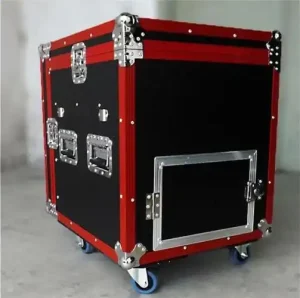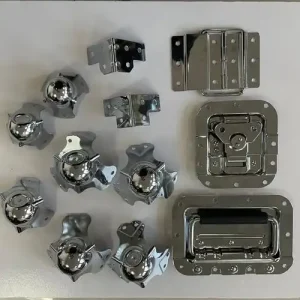Flight cases are widely used in the transportation, storage, and presentation of sensitive equipment. Their application spans across industries such as education, military, and entertainment.
However, the performance of a flight case depends not only on its design but also on the quality of its accessories and how it is used. In this article, we’ll explore the essential factors in selecting accessories for aluminum flight cases and the key considerations during usage.

Core Components of an Aluminum Flight Case
An aluminum flight case is more than just a box. It’s a well-structured protective system, typically made of:
Aluminum alloy frame – the skeleton that determines the case’s strength and stability.
Plywood panels – usually ranging from 9mm to 18mm, used for the body and base depending on load capacity.
Shock-absorbing lining – EVA foam or pearl cotton lining protects the items inside from impact and vibration.
Hardware components – such as locks, handles, corner protectors, and wheels. These directly affect durability and usability.
Every component plays a crucial role. Poor material choices or low-quality accessories can lead to premature wear, safety hazards, or equipment damage.
How to Choose the Right Flight Case Accessories
Aluminum Profiles: The Backbone of Strength
Choose anodized aluminum profiles. These offer higher corrosion resistance and preserve their appearance over time. Avoid thin or untreated profiles, as they tend to oxidize and deform quickly under pressure.
Plywood Panels: Thickness Matters
The thickness of the plywood should match the intended load. Lighter applications can use 9mm panels, while heavy-duty use requires 12mm or even 18mm. Avoid low-grade materials like MDF or particle board, which swell in moisture and lose strength over time.
Lining Materials: Balanced for Performance
EVA foam and pearl cotton are both common choices for interior padding. The right balance of density, hardness, and thickness is essential. Foam that is too hard won’t absorb shock; too soft will collapse easily.
Use industrial-grade glue like Weigang adhesive, known for heat resistance and aging durability. This ensures the lining stays secure even in hot outdoor conditions.
Hardware: Small Parts, Big Impact
Use galvanized steel rather than chrome-plated hardware. While chrome looks nicer initially, it chips easily and rusts when damaged. Galvanized components form a self-protective layer, offering longer-lasting resistance to wear and moisture.

Choosing the Right Wheels
Wheels are a key feature of any flight case, impacting how easily it moves and how long it lasts.
Material: PU wheels are more durable than PVC and provide better shock resistance.
Load capacity: Select wheels based on the case’s total weight.
Brake system: Opt for single or double brakes if you need the case to stay in place.
Bearings: Dual-bearing wheels roll more smoothly and last longer.
Temperature resistance: Ensure the wheel material holds up in both hot and cold conditions.
High-quality wheels prevent damage during movement and ensure ease of transport, especially in frequent-use environments.
Usage Guidelines for Longevity
Though aluminum flight cases are strong and versatile, proper usage is still essential:
Never exceed the designed load limit. Overloading may cause panel deformation or joint failure.
Avoid prolonged exposure to direct sunlight. Even anodized aluminum and industrial adhesives can degrade under constant heat.
After use in humid environments, wipe down the case to prevent corrosion of metal parts.
Minimize violent impact, even with shock-absorbing lining. Repeated drops or hits reduce internal padding efficiency over time.
- Growing Market Demand and Innovation
The demand for aluminum flight cases continues to grow, especially in sectors requiring durable yet lightweight packaging. These cases provide 5–8 times the load-bearing capacity of regular cases, making them the preferred choice for high-value equipment.
Manufacturers are now investing in material innovation and structural optimization. The goal is to create cases that are both strong and portable, ideal for modern logistics and field applications.
When choosing or customizing a case, pay close attention to the materials, accessories, and construction quality. A well-built case doesn’t just protect your equipment—it represents your commitment to quality.


